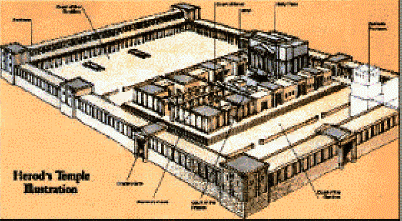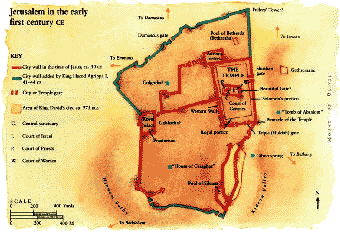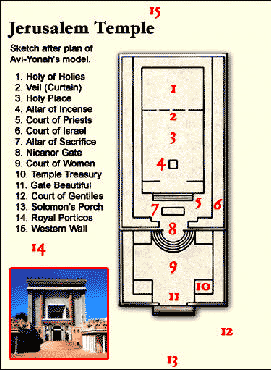The Baptism of Jesus by John
Sermon on Mark 1:4-11
preached by
The Reverend Charles Royden
12th January 2003
Additional information
What was the Temple like ?
The Jewish Temple in the First Century A.D.
Today the Moslem Dome of the Rock in Jerusalem is the prominent building where the Jewish temple once stood. When Jesus came to Jerusalem, the Temple had just been marvellously rebuilt by Herod the Great. The Temple area had been enlarged to a size of about thirty-five acres. Around the Temple area were double colonnades. The Jewish historian Josephus describes the colonnades:
"All the cloisters were double, and the pillars to them belonging were twenty-five cubits in height, and supported -the cloisters. These pillars were of one entire stone each of them, and that stone was white marble; and the roofs were adorned with cedar, curiously graven. The natural magnificence, and excellent polish, and the harmony of the joints in these cloisters, afforded a prospect that was very remarkable; nor was it on the outside adorned with any work of the painter or engraver. The cloisters -(of the outmost court) were in breadth thirty cubits, while the entire compass of it was by measure six furlongs, including the tower of Antonia; those entire courts that were exposed to the air were laid with stones of all sorts" (Jewish War 5. 5. 2).
The eastern portico was named after King Solomon and the part to the south, which overlooked the Valley of Kidron, was called "Royal." On the east side the high corner was possibly the pinnacle of the temple, mentioned in the story of the temptation of Jesus (Matthew 4:5).
There were eight gates leading into the temple.
There were the two Huldah Gates or "mole" Gates from the south, which passed underneath the Royal Porch.
To the east was the Gate of Susa, still visible as is the Golden Gate which was walled up by the Byzantines.
In the western wall was the main gate named the Gate of Coponius after the first procurator; it was decorated with the golden eagle as a sign that the Temple had been placed under the protection of Rome.
 Anyone was allowed to enter the
outer area, which was therefore called the Court of the Gentiles. The actual
Temple was enclosed by a balustrade, and at the entrances to it were warning
notices, one of them is now in a museum in Istanbul. It says that foreigners
have freedom of access provided they do not go beyond the balustrade which
went all around the central edifice and which no uncircumcised could cross
without incurring the death penalty.
Anyone was allowed to enter the
outer area, which was therefore called the Court of the Gentiles. The actual
Temple was enclosed by a balustrade, and at the entrances to it were warning
notices, one of them is now in a museum in Istanbul. It says that foreigners
have freedom of access provided they do not go beyond the balustrade which
went all around the central edifice and which no uncircumcised could cross
without incurring the death penalty.
Fourteen steps led through the Bea utiful
Gate to the Court of the women where the poor boxes were, into one of
which the poor widow cast her two mites (Luke 21:1-4).
utiful
Gate to the Court of the women where the poor boxes were, into one of
which the poor widow cast her two mites (Luke 21:1-4).
Another fifteen steps led up to the famous Gate of Nicanor, to which Mary had brought the child at the time of his presentation; this led through the Court of the Men to that of the priests, which had in its center the altar for the burnt offerings and to the left of it a large basin called the Brazen Sea resting upon twelve bulls cast in bronze.
Further steps led up to the actual temple, a comparatively small building. A priceless curtain, embroidered with a map of the known world, concealed from view what lay beyond, and none except the priest on duty was allowed to go farther.
It contained the golden altar at which incense was offered and next to it the seven-branched candelabrum and the table with the twelve loaves of shewbread, which were replaced by fresh ones every sabbath.
Beyond it, behind another large curtain, lay the Holy of Holies, which none except the high priest was allowed to enter, and he only on the Day of Atonement. A stone designated the place where once the Ark of the Covenant had stood.
 Jesus
came to the Temple at a very young age and in Solomon's Porch the boy argued
with the rabbis, astonishing them with his questions and with his answers.
He remained behind when his parents left, and when his worried mother at
last found him he said to her enigmatically: "'Did you not know that I must
be in my Father's house?"' (Luke 2:49). It is one of the most original
sayings of Jesus, in which he speaks of God for the first time as "avi" (My
Father) which was an expression reserved for the Son of God.
Jesus
came to the Temple at a very young age and in Solomon's Porch the boy argued
with the rabbis, astonishing them with his questions and with his answers.
He remained behind when his parents left, and when his worried mother at
last found him he said to her enigmatically: "'Did you not know that I must
be in my Father's house?"' (Luke 2:49). It is one of the most original
sayings of Jesus, in which he speaks of God for the first time as "avi" (My
Father) which was an expression reserved for the Son of God.
Today the Western Wall, the so-called Wailing Wall, is all that remains of the ancient walls of Herod's Temple; one can still see the pilaster and the beginning of Robinson’s Arch, which was part of a large viaduct leading to the upper city. Excavations in 1967, led by the well-known archaeologist Benjamin Mazar, revealed the cornerstone. Adjacent to it on the southern side remain traces of the road from which the pilgrims entered the gates.
Josephus Quotation
You may find the full works of Josephus through this link http://www.ccel.org/j/josephus/works/war-5.htm
‘As to the holy house itself, which was placed in the midst [of the inmost court], that most sacred part of the temple, it was ascended to by twelve steps; and in front its height and its breadth were equal, and each a hundred cubits, though it was behind forty cubits narrower; for on its front it had what may be styled shoulders on each side, that passed twenty cubits further.
Its first gate was seventy cubits high, and twenty-five cubits broad; but this gate had no doors; for it represented the universal visibility of heaven, and that it cannot be excluded from any place. Its front was covered with gold all over, and through it the first part of the house, that was more inward, did all of it appear; which, as it was very large, so did all the parts about the more inward gate appear to shine to those that saw them; but then, as the entire house was divided into two parts within, it was only the first part of it that was open to our view.
Its height extended all along to ninety cubits in height, and its length was fifty cubits, and its breadth twenty. But that gate which was at this end of the first part of the house was, as we have already observed, all over covered with gold, as was its whole wall about it; it had also golden vines above it, from which clusters of grapes hung as tall as a man's height.
But then this house, as it was divided into two parts, the inner part was lower than the appearance of the outer, and had golden doors of fifty-five cubits altitude, and sixteen in breadth; but before these doors there was a veil of equal largeness with the doors. It was a Babylonian curtain, embroidered with blue, and fine linen, and scarlet, and purple, and of a contexture that was truly wonderful. Nor was this mixture of colours without its mystical interpretation, but was a kind of image of the universe; for by the scarlet there seemed to be enigmatically signified fire, by the fine flax the earth, by the blue the air, and by the purple the sea; two of them having their colors the foundation of this resemblance; but the fine flax and the purple have their own origin for that foundation, the earth producing the one, and the sea the other. This curtain had also embroidered upon it all that was mystical in the heavens, excepting that of the [twelve] signs, representing living creatures.
In The Wars Of The Jews (The History Of The Destruction Of Jerusalem Book V A description of the Temple.)
Return to the sermon: The Baptism of Jesus by John
